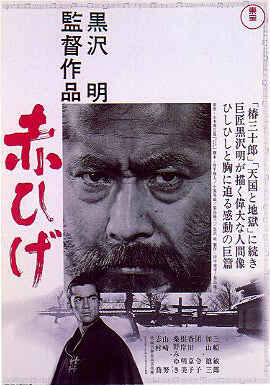Red Beard
Red Beard is a 1965 Japanese film directed by Akira Kurosawa. The film is notable for its exploration of humanism and the relationship between a doctor and his apprentice. It stars Toshiro Mifune in the titular role of Dr. Kyojō Niide, also known as "Red Beard."
Plot[edit | edit source]
The story is set in the late Edo period and follows the young and arrogant Dr. Noboru Yasumoto, who is assigned to a rural clinic run by the enigmatic Dr. Kyojō Niide, nicknamed "Red Beard." Initially resentful of his assignment, Yasumoto gradually learns the value of compassion and the importance of treating patients with dignity and respect.
Characters[edit | edit source]
- Dr. Kyojō Niide (Red Beard) - Played by Toshiro Mifune, he is the head doctor of the rural clinic and a mentor to Dr. Yasumoto.
- Dr. Noboru Yasumoto - A young and ambitious doctor who learns valuable life lessons under the guidance of Red Beard.
- Otoyo - A young girl who is rescued and treated at the clinic, symbolizing the transformative power of kindness and care.
Themes[edit | edit source]
The film delves into themes such as humanism, the ethics of medical practice, and the transformative power of compassion. It also explores the social issues of the time, including poverty and the role of women in society.
Production[edit | edit source]
Red Beard was the last collaboration between Akira Kurosawa and Toshiro Mifune, marking the end of a significant era in Japanese cinema. The film is known for its meticulous attention to detail and the extensive research Kurosawa conducted to accurately depict the medical practices of the Edo period.
Reception[edit | edit source]
Upon its release, Red Beard received critical acclaim for its direction, performances, and thematic depth. It is considered one of Kurosawa's masterpieces and has had a lasting impact on both Japanese and international cinema.
Legacy[edit | edit source]
Red Beard has influenced numerous filmmakers and is often studied in film courses for its narrative structure and character development. The film's emphasis on humanism and ethical medical practice continues to resonate with audiences and medical professionals alike.
See also[edit | edit source]
References[edit | edit source]
External links[edit | edit source]
Search WikiMD
Ad.Tired of being Overweight? Try W8MD's physician weight loss program.
Semaglutide (Ozempic / Wegovy and Tirzepatide (Mounjaro / Zepbound) available.
Advertise on WikiMD
|
WikiMD's Wellness Encyclopedia |
| Let Food Be Thy Medicine Medicine Thy Food - Hippocrates |
Translate this page: - East Asian
中文,
日本,
한국어,
South Asian
हिन्दी,
தமிழ்,
తెలుగు,
Urdu,
ಕನ್ನಡ,
Southeast Asian
Indonesian,
Vietnamese,
Thai,
မြန်မာဘာသာ,
বাংলা
European
español,
Deutsch,
français,
Greek,
português do Brasil,
polski,
română,
русский,
Nederlands,
norsk,
svenska,
suomi,
Italian
Middle Eastern & African
عربى,
Turkish,
Persian,
Hebrew,
Afrikaans,
isiZulu,
Kiswahili,
Other
Bulgarian,
Hungarian,
Czech,
Swedish,
മലയാളം,
मराठी,
ਪੰਜਾਬੀ,
ગુજરાતી,
Portuguese,
Ukrainian
Medical Disclaimer: WikiMD is not a substitute for professional medical advice. The information on WikiMD is provided as an information resource only, may be incorrect, outdated or misleading, and is not to be used or relied on for any diagnostic or treatment purposes. Please consult your health care provider before making any healthcare decisions or for guidance about a specific medical condition. WikiMD expressly disclaims responsibility, and shall have no liability, for any damages, loss, injury, or liability whatsoever suffered as a result of your reliance on the information contained in this site. By visiting this site you agree to the foregoing terms and conditions, which may from time to time be changed or supplemented by WikiMD. If you do not agree to the foregoing terms and conditions, you should not enter or use this site. See full disclaimer.
Credits:Most images are courtesy of Wikimedia commons, and templates Wikipedia, licensed under CC BY SA or similar.
Contributors: Prab R. Tumpati, MD


